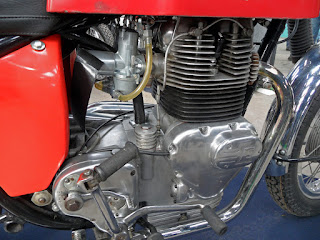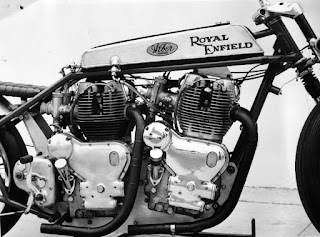 |
| The 1933 Royal Enfield factory ISDT team had Albion "H" gear clusters in their Model LF Bullet 500s. (Photo from REOC archives.) |
When I bought my old Royal Enfield motorcycle, I realized nothing more determined what it was like to ride than its four-speed Albion gearbox, with its neutral finder lever.
I could easily forgive and forget that my 1999 Bullet lacked electric start, had drum brakes, a single-cylinder motor and not a lot of power. But the rough hewn Albion transmission reminded me four times after every stop (once for each gear, not counting false neutrals) that it was the Boss.
And it had been, for a very long time.
Royal Enfield owners the world over celebrated the 70th anniversary of the post-war Bullet in 2019. Yet, when the popular 350 Bullet first went on sale in 1949, the use of this gearbox in Royal Enfield motorcycles was already at least 16 years old!
It was Bob Murdoch, Royal Enfield Owners Club (UK) archivist, who reminded me of Albion's remarkable history with Royal Enfield motorcycles.
"With all the parts books at my disposal, I thought I'd delve a bit further into the past, to the birthday of the much-maligned Albion four-speed positive-stop gearbox whose internals remained mostly unchanged until the last classic Bullets left the Indian factory," he wrote in an email.
 |
| By 1956 the Albion gearbox had the shape we recognize today, and the familiar neutral finder lever. (Photo from REOC archives.) |
Bob dates Royal Enfield's use of the Albion gearbox we love/hate to 1933. The Albion was Royal Enfield's first production positive stop, foot-shift, four-speed gearbox. It did not at first have the distinctive neutral finder lever. Albion Engineering patented the neutral finder in 1944 and it first appeared on Royal Enfields in 1946.
Bob quotes Henry Price of Price Parts, a UK-based Royal Enfield parts dealer, to the effect that people moan and groan about the Albion, but it works very well, and if operated as intended is very good and reliable, simple to repair and easy to maintain.
The five-speed transmission that replaced the old Albion on Royal Enfields arrived in the U.S. on 2004 models. The five speed was designed from the beginning to shift on the left, the modern international standard, and mandatory in the U.S.
The five speed was considered improved enough to give up the neutral finder lever. Until then it had been said of Royal Enfield that it was the only motorcycle in the world with a neutral finder, and the only motorcycle in the world that needed one.
The years 1933 to 2004 make a 72-year Royal Enfield history for the ancient Albion four speed. How did it do it?
"The reason the same gearbox was fitted to your 1999 Bullet is because it worked, and could easily cope with 23 bhp. Why spend money designing and developing a new one for a 1940s motorcycle design?" Bob explained.
Royal Enfield's Albion gearbox did not remain completely unchanged for all those years.
"It was on its limit for the more aggressive power delivery of the big twin-cylinder bikes, and perhaps the Fury scrambler," Bob wrote.
 |
| Damaged small-tooth Albion gears from a Royal Enfield Constellation. The easy fix was using fewer but larger teeth on same dimension gears. (Photo courtesy Bob Murdoch.) |
"The gearbox was unchanged until the increased power of the big twins caused broken gear teeth. The tuned factory Super Meteor on the production race tracks of 1958 is said to be the reason for larger but fewer teeth to be employed around that time, and standardized from 1959 in the UK, but the first gearbox failures may have arisen in the USA on the Indian twins.
"A new larger gearbox was really needed, but instead Albion opted for a cheap fix, keeping all shafts, distances between shaft centers, bearings etc. So the external diameter of gears remained the same, but the teeth became fewer and stronger. The number of teeth maintained the same ratio as before with its 'partner,'" Bob explained.
Bob himself has witnessed gearbox failures. He thinks these are the reason Royal Enfield adopted two rubberized cush drives (in clutch and in rear wheel) from the early 1950s: to soften the drive take-up and reduce gearbox stresses.
Despite weaknesses, the Albion gearbox could prove surprisingly capable, Bob noted.
 |
| Prototype 800cc Royal Enfield Interceptor used the Albion gearbox. (Photo from REOC archives.) |
"Richard Stevens rode several thousand test miles on a prototype 800cc Interceptor from the Upper Westwood factory, which recorded a one-way speed of 123 mph on the standard four-speed gearbox.
"In 1969 the Enz and Sliger double-engined Interceptor sprinter seems to have used a standard four-speed gearbox, including a kickstart, to the unstreamlined world record!"
 |
| 1969 Enz and Sliger double-engined Interceptor with one gearbox. (Photo from REOC archives.) |
As REOC archivist, Bob knows the importance of the Albion gearbox in Royal Enfield history.
Anyone searching for more information about Albion will encounter Don Morley's colorfully written article in Classic and Motorcycle Mechanics magazine of October, 1991. He wrote:
"The problem was Albion could never quite forget they earned most of their serious money from providing remarkably similar but much heavier such components for military use. Tanks and battleships, for example.
"They had never been particularly well known amongst two-wheeled circles for their products' delicacy or finesse. Not least because their virtually unilateral design of gearbox was an adaption of one they provided for industrial lathes!
"Put simply, Messrs. Albion more or less re-scaled this same lathe box's components up or down in size to suit any and all other applications."
Morley gives this example:
"Such was the degree of interchangeability that the gear pinions used inside Villier's 1952 onwards, semi-unit construction, four speed 7E type gearbox can even be interchanged quite happily with the above mentioned and appreciably later period 250cc unit-construction four-speed Royal Enfield."
Whatever else is know about the Albion design, it clearly worked. Grace's Guide to British Industrial History claims that "Albion gearboxes were fitted to Aston, Calthorpe, Carfield, Cotton, Coventry-Eagle, Dot, Elfson, Greeves, Hailstones and Ravenhall, Haden Precision, Lily, McKenzie, Metro-Tyler, Priest-JAP, Priory, Radco, Rex-Acme, Ruby, Saxelby, Spur, Sun, Talbot, Triplette, Triumph Gloria, Weatherell, Whitworth and many other British motorcycles. European marques utilizing Albion included Monet-Goyon of France, Ancora, Bianchi and MM of Italy, Rex of Sweden and many others."
(If you read the previous paragraph you probably were delighted to learn that there ever was a motorcycle named "Hailstones and Ravenhall." I was.)
Like Albion's other customers, Royal Enfield had the gearbox parts it needed delivered from Albion. (As far as I can learn, Albion gearboxes were not made in Royal Enfield's own UK factories.)
 |
| Albion was a small firm, sharing a stand with another firm at the 1929 Olympia Show. |
Jorge Pullin notes in his MyRoyalEnfields blog item on the neutral finder that the Albion Engineering company was located on Upper Highgate Street in Birmingham, UK; but it is there no longer. Other sources indicate that in the 1950s Albion Engineering was on Sampson Road North in Birmingham.
Grace's Guide to British Industrial History has little information on Albion. Albion Engineering, the maker of gears and gearboxes for Royal Enfield, was apparently unrelated to the big Albion Automotive firm, maker of cars, trucks and buses.
Royal Enfield ceased production of motorcycles in the UK by 1970. So how did the Albion design get on my made-in-India 1999 Royal Enfield Bullet? Gordon May completes the story in his 120 Anniversary item:
"The five-speed gearbox fitted to some cast iron engines from 2002 onwards and the one incorporated within the UCE engine were modern, super slick designs that required little effort to efficiently click from fifth gear down to neutral. The much-lauded neutral finder was no longer needed and the last one left Royal Enfield’s Thiruvottiyur factory in 2010 on the final cast iron 350 Bullets.
"But for those enthusiasts who still keep their older Enfields running, whether Indian or British, the neutral finder, with its unique way of finding neutral, remains a huge asset – and is always a quirky talking point."
























I've never understood the dislike of the Albion. The ones I've used, including my current 1964 Interceptor one, have been very easy to use. They can be fiddly to set up, which makes me wonder if most of the complaints weren't because of poor adjustment.
ReplyDeleteI agree. The neutral finder, for instance, remains a helpful device and is so integrated into my riding style that I do not know how I would do without it.
DeleteReally interesting article
ReplyDeleteHi fellas I own two 1969 rokon mk3's fitted with a 3 speed Albion EJ I believe. It's stamped " mrd 556" is this a model or manufactured date? Are there parts kits available for these gear boxes, service/set up info? Where would one source a good used unit from thanks Joseph in Michigan
ReplyDeleteGraham Scarth, who has studied numbers associated with Royal Enfield motorcycles, including gearbox numbers, sent me this, in response: "Royal Enfield used Albion gearboxes from the early 1930’s as far as I know.
DeleteThese were the H series heavyweight box on 350 ohv and larger and the R series mediumweight (?) box on 350 side valve and smaller. The unit construction Crusader 250 range has R type internals I believe. Not sure what was used in three speed Model RE 125cc two stroke or 150cc Ensign / Prince. I do not know whether Albion had an M series box (MRD ?) but looking on the Rokon website at spare parts, the photos of the gears show them to not be splined like those in RE’s." The Rokon website for spare parts is Rokon.com